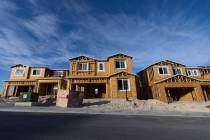EDITORIAL: State needs plan to start school construction this year
The state’s most urgent education problem can’t be adequately, immediately addressed under existing budgets and law. It’s going to take big ideas and fast action by Gov. Brian Sandoval and the 2015 Legislature to add more classroom space and relieve the extreme crowding created by enrollment growth, especially within the Clark County School District.
The school district, the country’s fifth-largest K-12 system, has more than 319,000 students, and more are showing up at campuses every day. Elementary school enrollments are 18 percent over the capacity of permanent buildings. Ten schools were converted to year-round calendars this year, and the attendance boundaries of 17 others were redrawn. The district is prepared to rezone and convert more schools to year-round calendars next year. It cannot build a single new school because it is out of capital money from its 1998, $4.9 billion bond.
The Clark County School Board appears intent on placing a $2 billion bond on the 2016 ballot, but if voters approve it, the system’s first new school wouldn’t open until 2019 at the soonest. By then, the school district could have an additional 20,000 students — or more. The worse the system’s space crunch gets, the more impact it will have on new home construction and job creation.
Gov. Sandoval unveils his 2015-17 budget and his education agenda in tonight’s State of the State address. Whatever achievement initiatives he proposes, and whatever pitches he makes to bring more companies to the state, they will have less benefit if the only places to pile new students are portable classrooms.
At crowded schools. On year-round schedules.
That’s why Gov. Sandoval and lawmakers must pursue the Review-Journal’s eighth of 25 policy recommendations in 25 days: enact multiple ways to start new school construction this year.
One proposal appears to have broad, bipartisan support: a rollover of bonding authority from 1998 that would let the school district immediately start building a few new schools.
New school district campuses are part of the solution. But so is school choice.
Charter school campuses can be built much faster and much cheaper than traditional school district campuses. Some charters have custom-built campuses. Some have been built in renovated office space and pay rent. And charters are not subject to the state’s prevailing wage law, which greatly inflates public-sector construction costs.
But charter schools, unlike traditional public schools, do not receive capital revenue from the state. They receive only the approximate per-student state allocation given to public schools. That means charters must use instructional money to help pay for facilities. A bill signed into law by Gov. Sandoval in 2013 gives charters access to state bonds, which carry lower interest charges than the conventional bank loans many charters used to build their campuses.
If Gov. Sandoval really wants to give charters a boost — and get more new schools built right away — he’ll find a way to provide charter schools with dedicated capital/facility money separate from per-student funding.
These two measures alone could get a dozen new schools built in Southern Nevada by summer 2016, which is far better than none at all. New school construction can’t wait.

25 ideas in 25 days
PREVIOUS: School maintenance
NEXT: Voter photo ID























